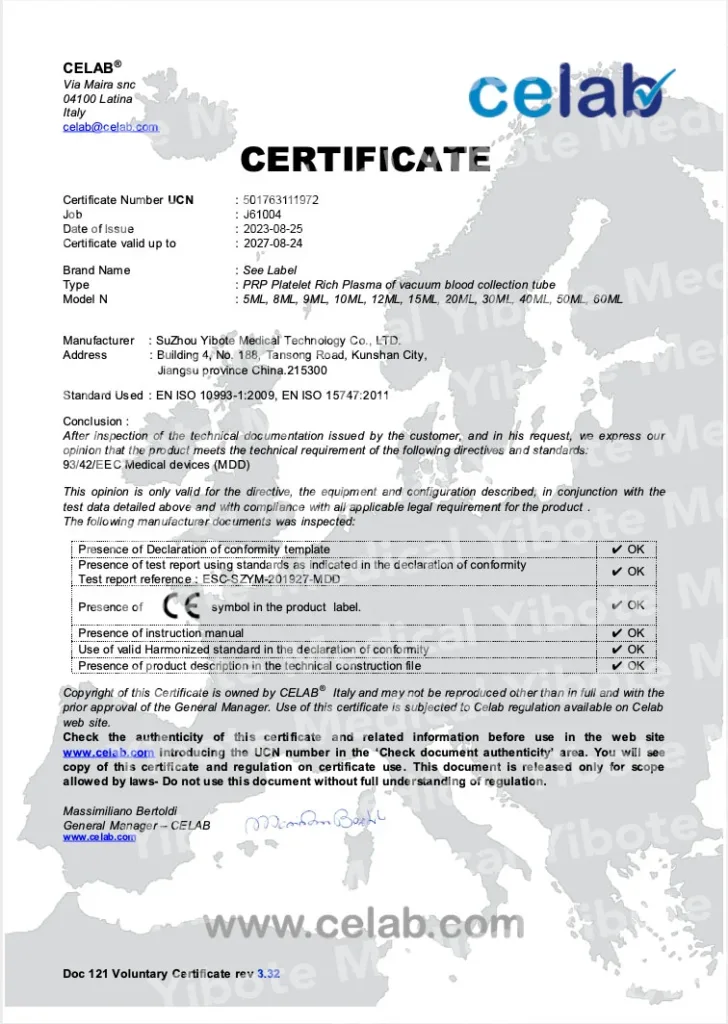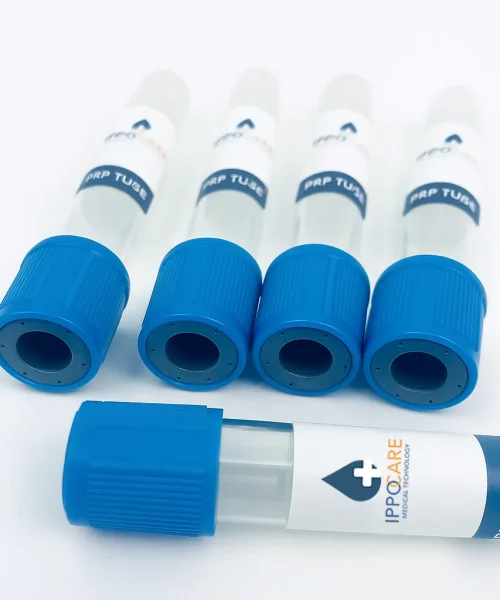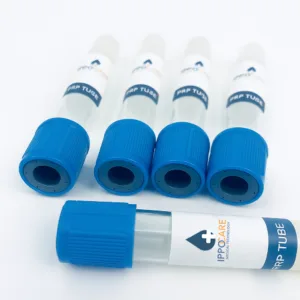Platelet-Rich Plasma (PRP) therapy has become one of the most trusted regenerative procedures in aesthetic and medical fields — from hair restoration to facial rejuvenation and wound healing. But behind every successful PRP treatment lies a single, often-overlooked tool: the PRP collection tube.
What’s actually inside a PRP tube? Why do the anticoagulant, separating gel, and tube material matter so much? Let’s break down the science and engineering that determine how much usable plasma you truly get.
What Makes Up a PRP Tube?
A PRP tube might look like a simple blood collection container, but it’s a highly specialized medical device. Its internal composition is designed to preserve platelets, separate plasma, and maintain sterility throughout the centrifugation process.
The essential components of a PRP tube include:
- Anticoagulant Solution (commonly ACD-A) – prevents premature platelet activation.
- Separation Gel – forms a physical barrier between plasma and red blood cells.
- Sterile Vacuum Environment – ensures precise negative pressure for consistent blood draw.
- Tube Material (Glass or PET Plastic) – influences platelet recovery and sterility.
Each of these factors contributes directly to PRP purity, platelet concentration, and clinical results. Even subtle differences—such as the type of gel or the grade of anticoagulant—can alter plasma yield by up to 30%.

The Role of ACD in Preserving Platelets
Anticoagulant Citrate Dextrose (ACD) is the lifeline of any PRP tube. It’s what keeps platelets intact from the moment blood enters the tube until centrifugation is complete.
Why ACD Matters:
- Citrate ions bind calcium in the blood, temporarily stopping the clotting cascade.
- Dextrose provides energy to platelets, preventing degradation during the spin.
- The result: platelets remain viable and ready for activation when re-introduced into the skin or scalp.
Without a proper anticoagulant, the collected blood would clot inside the tube within minutes, destroying platelets and rendering the PRP useless.
ACD vs. Heparin or Sodium Citrate
While other anticoagulants exist, ACD (especially Type A) is preferred in aesthetic and regenerative medicine because it maintains optimal platelet morphology without altering growth factor release.
At IPPOCARE, for instance, our Classic PRP Tube (ACD + Gel) uses medical-grade ACD solution measured precisely for a 10 mL or 12 mL vacuum. This ensures both safety and reproducible plasma yield across treatments.
Why Separation Gel Improves Plasma Quality
The separation gel is what gives modern PRP tubes their consistency and purity. After centrifugation, the gel rises to create a barrier between plasma and the lower blood layers (RBCs and buffy coat).
Benefits of Separation Gel
- Prevents erythrocyte contamination, keeping the plasma clear and golden.
- Stabilizes platelets by isolating them from hemolysis byproducts.
- Simplifies plasma extraction—clinicians can easily draw the supernatant without disturbing other layers.
Gel Density and Centrifuge Balance
The density of the gel is engineered to migrate precisely between plasma and blood cells at a specific G-force. If the gel is too light, it mixes with plasma; too heavy, and it traps valuable platelets.
That’s why only CE-approved medical-grade gels are recommended. Low-quality gels can leach compounds into the sample, reducing platelet viability and potentially triggering unwanted immune responses.
In short: the gel decides the purity—and purity decides the success of your PRP.

Common Tube Materials: Glass vs. PET
Tube composition is often ignored, yet it plays a subtle role in the biological integrity of PRP.
Glass Tubes
- Excellent clarity and chemical inertness.
- Often provide more stable platelet recovery.
- Heavier and more fragile—require careful centrifugation balance.
- Slight risk of platelet adhesion to glass surface if coating is poor.
PET (Polyethylene Terephthalate) Tubes
- Lightweight, durable, and shatter-resistant.
- Ideal for high-speed centrifuges used in clinics.
- Require a medical-grade interior coating to prevent platelet activation.
Many clinics now favor vacuum glass tubes for precision and PET tubes for practicality—but what truly matters is quality control and sterility validation by a certified manufacturer.
When choosing tubes, always look for gamma-sterilized, vacuum-sealed, and CE or ISO certified documentation. It’s not just about convenience—it’s about consistent regenerative results.
Why CE Certification Matters for Composition
CE certification isn’t a marketing term—it’s a legal medical-device qualification under European health and safety standards. For PRP tubes, CE marking guarantees that:
- Each component (ACD, gel, cap, material) has been biocompatibility-tested.
- The product was sterilized according to ISO 11137 standards.
- Manufacturing follows ISO 13485 quality management systems.
This means every batch of tubes you receive performs the same way in plasma separation, anticoagulation, and platelet concentration.
Clinics using non-certified tubes risk cross-contamination, inconsistent yields, and even regulatory penalties.
At IPPOCARE, our CE-certified PRP Tubes undergo triple sterilization—ETO, gamma, and UV—to ensure safety and efficacy. The controlled composition and medical-grade materials guarantee consistent plasma results in every procedure.

How Tube Quality Affects PRP Yield
Ultimately, PRP therapy’s success depends on how many functional platelets you deliver back into the body. Tube design directly influences that number.
| Factor | Impact on Yield | Description |
|---|---|---|
| Anticoagulant Volume | Prevents clotting, maintains platelet count | Too little → premature coagulation |
| Gel Density | Determines clean separation | Too dense → traps platelets |
| Tube Material | Affects platelet activation | Poor coating → platelet loss |
| Sterility & Certification | Ensures consistency | Non-certified tubes → variable yield |
Common Clinical Observations
- High-quality PRP tubes produce 1.5×–2× platelet concentration compared to whole blood.
- Inferior tubes can reduce yield by up to 40% due to clumping or gel contamination.
- Platelet degradation directly lowers growth factor release—reducing treatment efficacy.
By selecting a properly composed, CE-certified tube with ACD and separation gel, practitioners ensure not only clinical precision but also patient safety.
Composition Defines Quality
Every PRP tube is more than a container—it’s a precision-engineered medical instrument. The synergy between ACD anticoagulant, separation gel, sterile vacuum, and CE-compliant materials determines whether your PRP is truly “platelet-rich.”
When you understand what’s inside the tube, you control the quality of your results.
At IPPOCARE, we believe in science-driven design. Our PRP tubes are manufactured under strict CE and ISO certification, ensuring reliable platelet concentration and plasma purity for every clinic.
🔗 Explore our CE-Certified PRP Tubes →
🔗 Learn more about our ACD + Gel PRP Tube design →
FAQ
ACD prevents clotting by binding calcium, maintaining platelet viability during centrifugation.
It forms a barrier after centrifugation, isolating plasma from red and white cells for clean extraction.
Check the packaging for CE mark, manufacturer number, and corresponding ISO 13485 certificate.



